The Radeon HD 7970 Reprise: PCIe Bandwidth, Overclocking, & The State Of Anti-Aliasing
by Ryan Smith on January 27, 2012 4:30 PM EST- Posted in
- GPUs
- AMD
- Radeon
- Radeon HD 7000
Overclocking Revisited
While we’ve taken a look at overclocking the Radeon HD 7970 in our review of XFX’s Radeon HD 7970 Black Edition Double Dissipation, that was a look at XFX’s custom cooled card. We’ve had a number of requests for overclocking performance on our reference card, so we’ve gone ahead and done that.
In the meantime though a couple interesting facts have come to light. While both our reference card and our XFX card ran at 1.175v, it turns out that this is not the only voltage the 7970 ships at. Retail buyers have reported receiving cards that run at 1.112v and 1.05v, and Alexey Nicolaychuk (aka Unwinder), the author of MSI Afterburner, has discovered that there’s a 4th voltage according to the fuses on Tahiti: 1.025v. 1.025v has not been seen in any retail cards so far, and it’s most likely a bin that’s reserved for future products (e.g. the eventual 7990), while out of the remaining 3 voltages 1.175 appears to be the most common.
| Radeon HD 7900 Series Voltages | ||||
| Ref 7970 Load | Ref 7970 Idle | XFX 7970 Black Edition DD | ||
| 1.17v | 0.85v | 1.17v | ||
In any case, in overclocking our reference 7970 we’ve found that the results are very close to our XFX 7970. Whereas our XFX 7970 could hit 1125MHz without overvolting, our reference 7970 topped out at a flat 1100MHz. Meanwhile our memory speeds reached 6.3GHz before performance began to dip, which was the same point we reached on the XFX 7970 and not at all surprising since both boards use the same PCB.
Overall this represents a 175MHz (18%) core overclock and 800MHz (15%) memory overclock over the stock clocks of our reference 7970. As we’ll see, since this is being done without overvolting the power consumption hit (and all consequences thereof) from this is minimal to non-existent, making this a rather sizable free overclock.
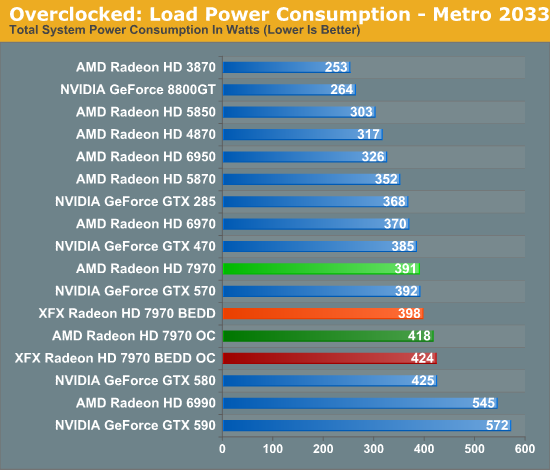
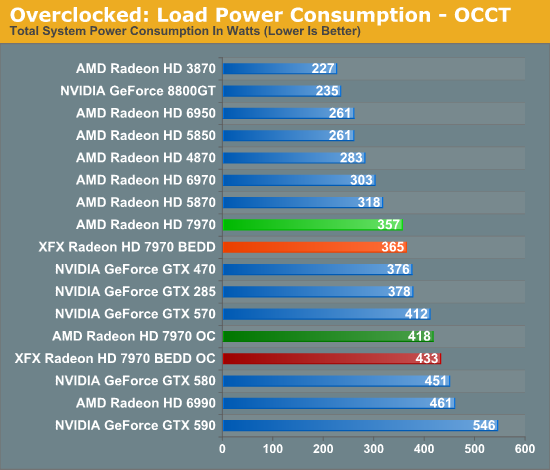
Taking a quick look at power/temp/noise, we see that the increase in load power is consistent with our earlier results with the XFX 7970. Under Metro the power increase is largely the CPU ramping up to feed the now-faster 7970. While under OCCT we’re seeing the consequence of increasing the PowerTune limit so that we don’t inadvertently throttle performance when gaming.
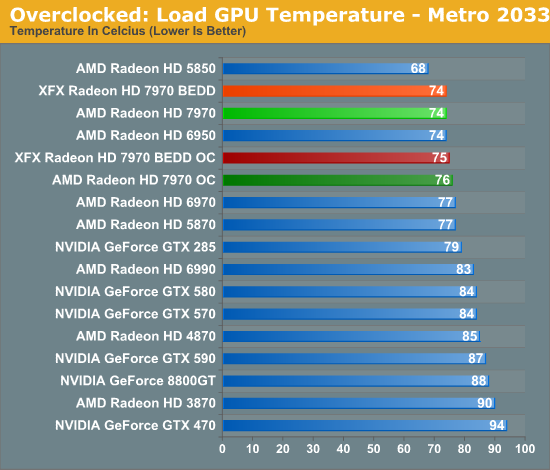
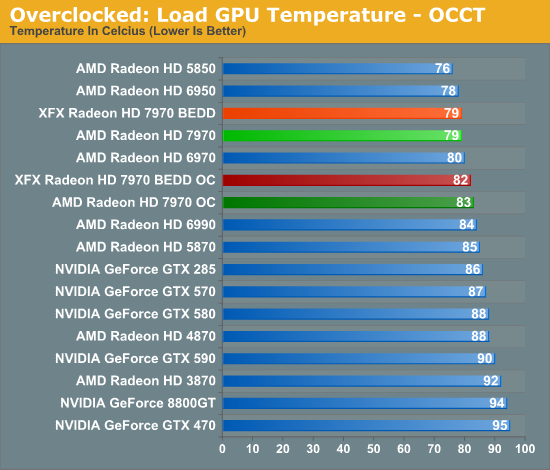
With almost no increase in GPU power consumption while gaming, temperatures hold steady. This translates to a 2C increase in temperatures, while under OCCT the difference is 4C.
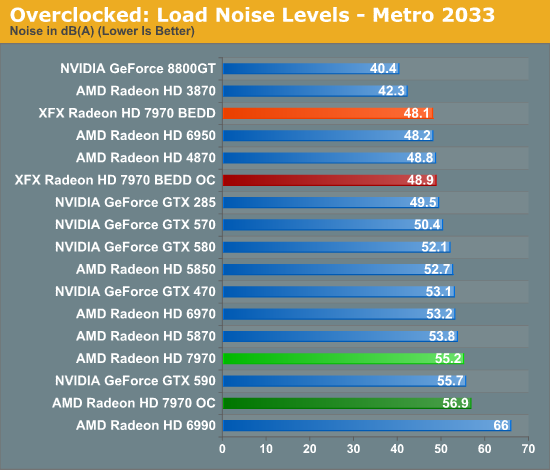

Finally, as with temperature, noise only ever so slightly creeps up. Unfortunately for most users, AMD’s already aggressive fan profile makes this relatively loud card just a bit louder yet; the temperatures are fantastic, but the noise less so. Things look even worse under OCCT, but again this is a pathological test with PowerTune increased to 300W.
Meanwhile gaming performance is where you’d expect it to be for a card with this degree of an overclock. As most tests scale very well with the increase in the core clock virtually all of our games are 15-20% faster over a reference 7970. Whereas compared to the XFX 7970, at 98% of the XFX 7970’s overclock, our overclocked reference 7970 is only a couple percent behind the XFX card and barely outside the margin of error of most tests.
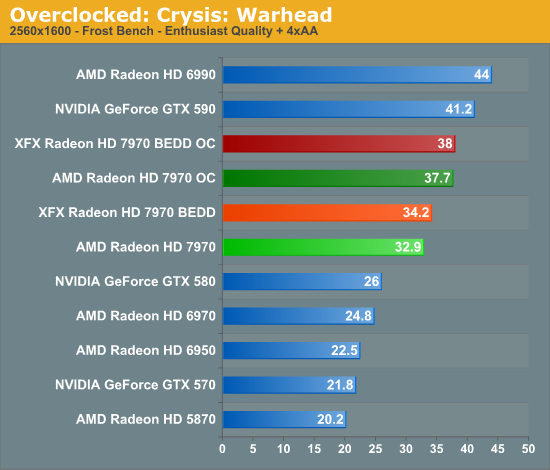
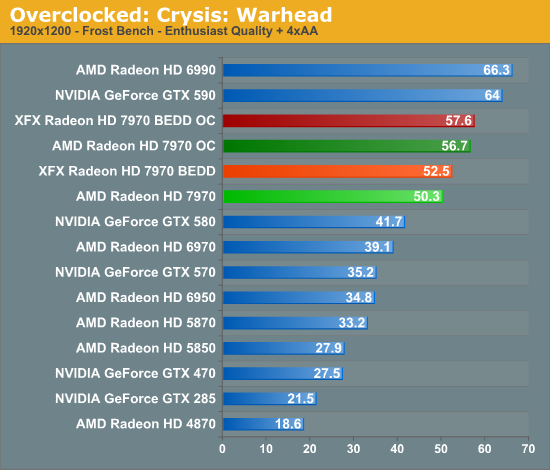

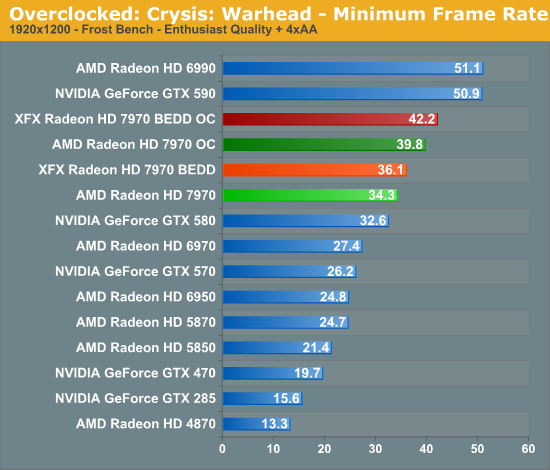
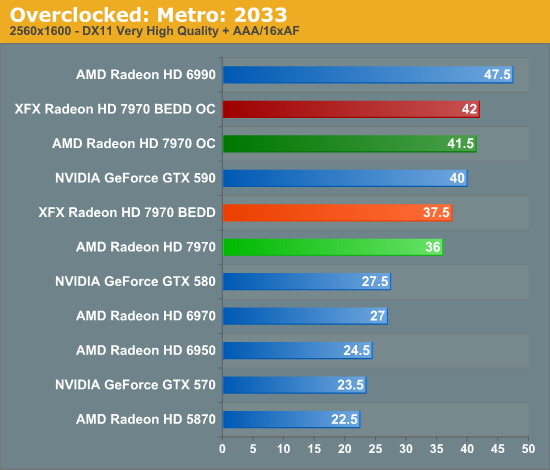

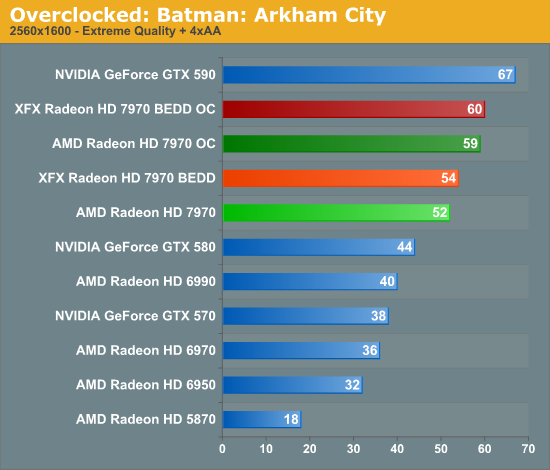
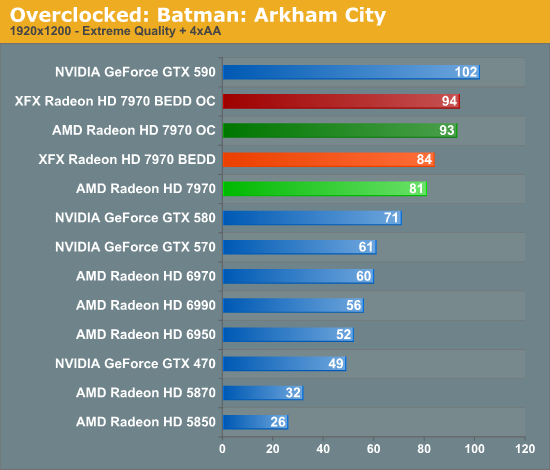
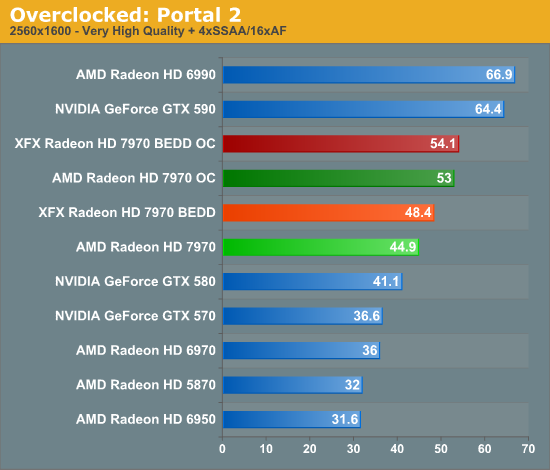
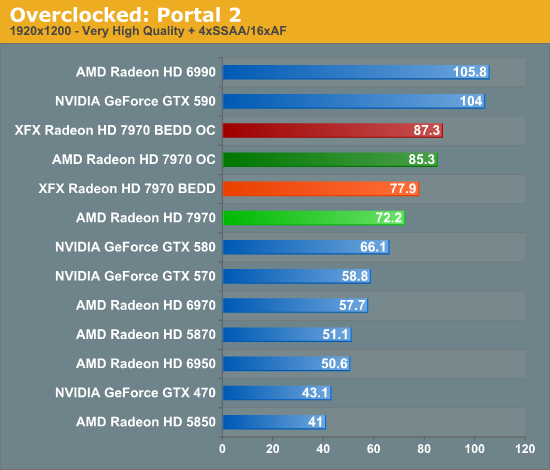
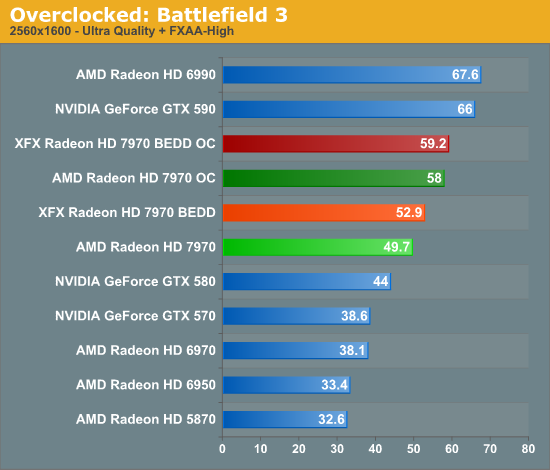
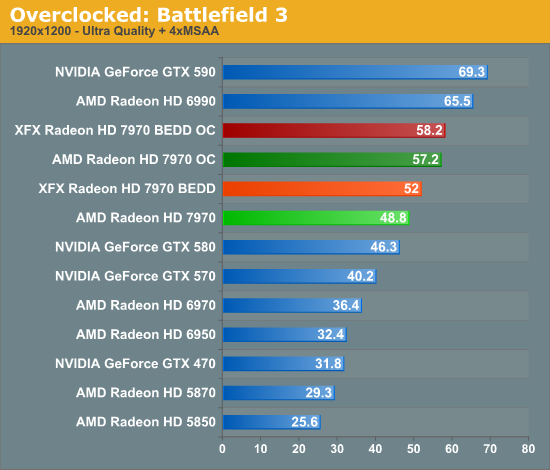
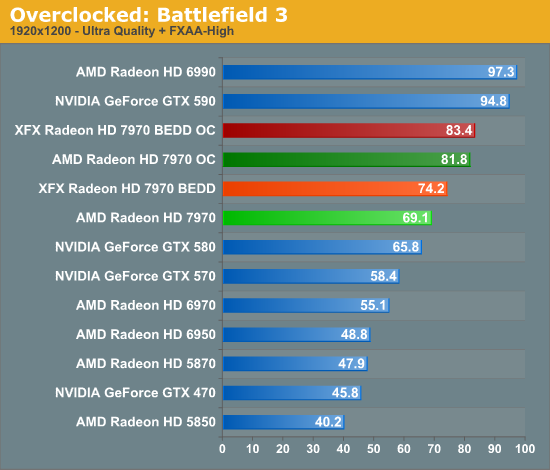
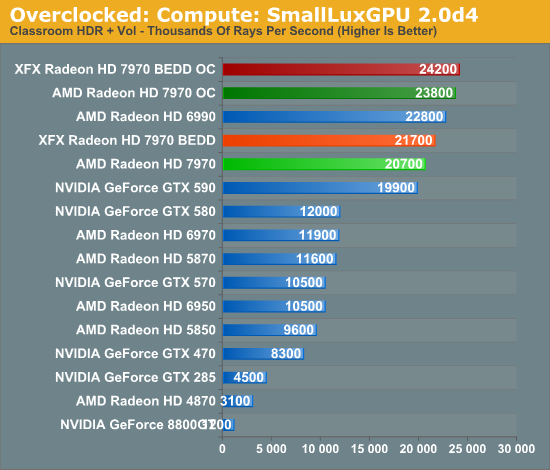
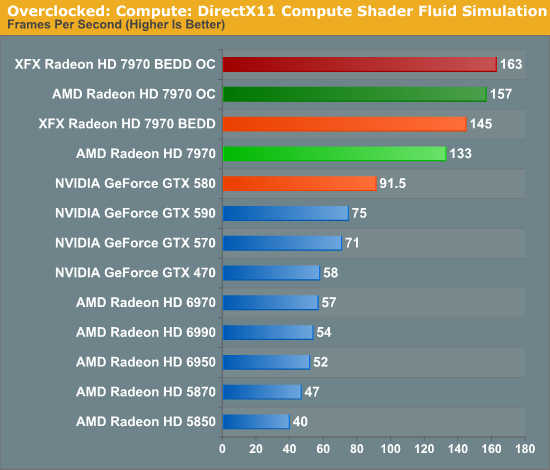
All things considered, outside of warranty restrictions there seems to be very little reason not to overclock the 7970 on its default voltage. Even a conservative overclock of 1050MHz would add 13% to the core clocks (and as a result performance in virtually all GPU-limited scenarios), which is a big enough leap in performance to justify spending the time setting up and testing the overclock. By not raising the core voltage there’s effectively no power/noise tradeoff and this seems to be achievable by virtually every 7970, making this a freebie overclock the likes of which we’re more accustomed to seeing on high-end CPUs than we are flagship GPUs.










47 Comments
View All Comments
shin0bi272 - Friday, January 27, 2012 - link
LOL yeah cause with Nvidia's 780 coming out in a month Im gonna go blow a load of cash on a card that's only marginally faster than the 580... riiiight. Nvidia released a slide of performance for their 780 vs the 580... the 780 was more than twice as fast as the 580 in all the games they tested.... some almost 2.5X as fast. If the rumored specs are true it will have almost identical specs to the 590 only on a 28nm die in a single chip. This is why you never jump at the first offerings of a new generation of cards. Especially when, if youve been doing your research, you know both chips are being made at the same foundry and both taped out about the same time and that amd went with the lower power chips first instead of the high k metal gates like nvidia did. Now Nvidia is doing a hard launch not a paper launch the end of march. Way to jump the gun dude.mak360 - Saturday, January 28, 2012 - link
And then you woke up!!DanNeely - Sunday, January 29, 2012 - link
Rumors are nVidia's new flagship GPU will have 1024 cores; so a slightly more than 2x speedup seems reasonable once you factor the architectural tweaks in.Sabresiberian - Saturday, January 28, 2012 - link
He, yeah, riiiight!SAAB_340 - Saturday, January 28, 2012 - link
Microsoft Flight Simulator X is a "game" that is limited by a 16x PCIe 2.0 bus. (when not using the buggy DX10 preview). You would easily find this when you fly low over a forest with loads of autogenerated trees.marc1000 - Saturday, January 28, 2012 - link
What about the 7950? And 7870? Amd wil loose momentum if it takes too long to launch new cards.Sabresiberian - Saturday, January 28, 2012 - link
"For any given game the amount of data sent per frame is largely constant regardless of resolution, so we’ve opted to test everything at 1680x1050."What causes the higher resolutions to require significantly more GPU power then?
;)
Ryan Smith - Monday, January 30, 2012 - link
The additional pixels that must be rendered. The setup data (triangles, textures, etc) are constant, but the actual rendering workload scales with the resolution of the image to be rendered.AstroGuardian - Sunday, January 29, 2012 - link
Yesterday you scared the crap out of me when Anandtech was unavailable. I thought it was another victim of the damn SOPA and stuff....Damn glad to see you guys again :)
fausto412 - Sunday, January 29, 2012 - link
We need focus back on driver support, bug fixing and quality. Shouldn't have to wait 3 months for proper drivers for a card you bought or for a hot new game like BF3.